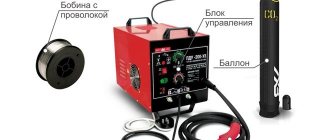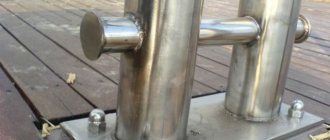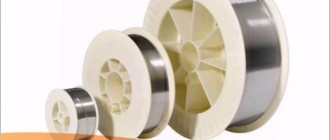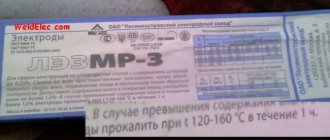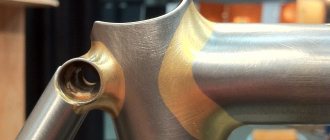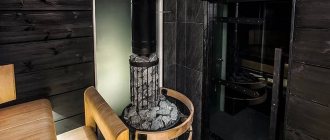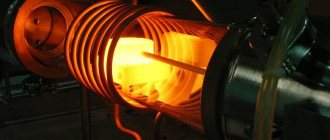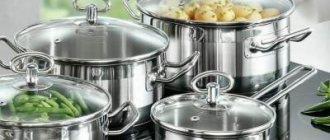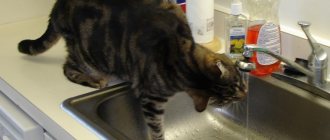The most common way to work with stainless steel is welding. The welding process has several features:
- a low level of weldability significantly affects the formation of the joint;
- the low thermal conductivity of stainless steel leads to the fact that the welded products melt through even at fairly low current values;
- a high coefficient of expansion means that when heated, the product seems to stretch. While when cooling, a tightening effect appears. Foreign metal, which is part of the structure of the main structure and has a lower expansion coefficient, leaves microcracks . Therefore, it is important to choose the right consumables;
- , intergranular corrosion occurs in stainless steel products . To avoid this, you need to carefully select the welding mode, as well as forcefully cool the parts being welded.
Welding with electrodes on stainless steel
Welding corrosion-resistant steels is a complex and time-consuming process. This procedure requires the performer to have theoretical knowledge and practical experience. Another important criterion for comfortable welding work is the correct choice of electrodes.
The special characteristics of stainless steel, as well as several welding features of this material, require the use of special welding materials . Welding stainless steel with a properly selected electrode is a guarantee of reliability, strength and long service life of the finished product.
Classification of special purpose electrodes
There are many criteria for classifying consumables, and this review does not aim to outline all possible types and classes. We are interested in stainless steel electrodes for high-alloy special alloys. Here's where they belong:
Electrodes by purpose
- for low-alloy carbon alloys, names begin with the letter “U”;
- for alloy steels with the initial letter “L”;
- for alloyed heat-resistant steels with the letter “T”;
- for high-alloy steel alloys with special properties with the letter “B”;
- for surfacing surfaces with special properties, letter “N”.
Types of coating and labeling standards.
We may also be interested in the classification of electrodes by type of coating (for more details on coatings, see below):
- A – acidic coatings;
- B – basic coatings;
- C – cellulose;
- R – rutile;
- mixed and other types of coatings.
The principles of marking electrodes on stainless steel are quite cumbersome. There is no purpose in this review to list them in full.
How to weld stainless steel with a regular electrode
Very often, novice welders ask themselves: can they weld stainless steel with conventional electrodes? It is important to note that welding corrosion-resistant steels with conventional electrodes is technically possible . In the absence or shortage of special welding materials, you can use simple consumables. Many craftsmen have repeatedly used this approach, but exclusively for processing parts for household use . Since increased requirements for reliability and solidity are applied to industrial structures.
From a technological point of view, it is recommended to use specialized electrodes with a suitable coating. Welding stainless steel with simple electrodes negatively affects the quality of the connection, and microcracks may also appear .
Conclusion! Therefore, welding stainless steel with conventional electrodes should be used as a last resort, only in an emergency or if you have little risk.
The question also often arises: is it possible to weld stainless steel using conventional welding? This also implies the possibility of using simple consumables for working with corrosion-resistant steels.
Video
We invite you to watch a short video where a DIYer shows how he welded the heat exchanger of a sauna stove with a black electrode. The comments show that opinions are divided on the admissibility of such welding, which makes this approach controversial.
Peculiarities
Stainless steel has some features that can have a significant impact on the welding process:
- Linear expansion and shrinkage of the material . When heated, stainless steel products “expand,” and when cooled, they “contract.”
- The thermal conductivity of stainless steel is almost two times less than that of other materials. Therefore, when welding it, the current should be reduced by 15-20%.
- Corrosion-resistant steels have a fairly high electrical resistance . Therefore, it is recommended to use only special electrodes for welding stainless steel.
- If you choose the wrong welding mode or select the wrong machine, stainless steel may lose its anti-corrosion properties . This happens as follows: when the product is heated to a temperature above 500°C, chromium and iron carbide is formed on the metal along the edge. This leads to oxidation. To prevent rust formation, structures should be cooled quickly using various methods.
Stainless steel welding methods
There are several methods for welding stainless steels. Each method involves the use of specific equipment and consumables. How to properly cook stainless steel with electrodes will be analyzed further.
Manual electrode
Manual welding of stainless steels with a coated electrode is universal and can be used in almost any industry. This method provides acceptable connection quality, so it is used by home and professional performers. Another important advantage of MMA technology is the simplicity and ease of the welding process. In addition, welding stainless steel with arc welding has several more advantages :
- affordability of electrodes and equipment;
- the devices can work throughout the working day;
- the units have compact dimensions and low weight, which allows you to quickly move around the work site;
- high speed of work with skillful handling of equipment and consumables;
- strength of welds;
- There is an opportunity to independently study this welding method and apply it in practice.
In order for a weld to be highly reliable, it is necessary to select the right welding materials. The following brands are suitable for manual welding:
OZL-8 are designed to weld products exposed to aggressive environments. At the same time, increased requirements for resistance to MCC are not imposed on the deposited metal. Performers use OZL-8 electrodes to process critical structures.
NZh-13 electrodes create a reliable connection and prevent the formation of ICC. A thin layer of slag crust disappears spontaneously after cooling and compression of the working area. This significantly speeds up the process when a large number of seams need to be completed.
TsL-11 electrodes are characterized by good insulation of the weld pool from external factors. This brand provides a strong connection.
When using this technology, direct current is used to weld stainless steel, the polarity is reversed.
After analyzing this information, a performer of any level will be able to learn how to weld stainless steel using arc welding.
Manual argon
Manual welding of stainless steel in an argon environment is carried out using tungsten electrodes. This technology guarantees high-quality and reliable seams. Moreover, the connections meet all the requirements, even if they are made at home. Consequently, argon arc welding is used when the performer needs an aesthetic result. The seams do not need to be cleaned of slag. There are no sparks during welding. This is the cleanest connection method . This method is also intended for working with parts with very thin walls.
Welding is carried out with alternating or direct current of straight polarity .
The type of stress depends on the thickness of the metal:
- if the thickness of the sheets being welded is 1 mm, then a direct current of 30-60 A is used, the diameter of the electrodes is 2 mm.
- Welding stainless steel with alternating current is also possible when working with elements 1 mm thick: voltage – 35-75 A, electrode Ø – 2 mm.
- data for processed products with a thickness of 1.5 mm: direct current of direct polarity, 40-75 A, Ø welding rod - 2 mm;
- alternating current, 45-85 A, Ø – 2 mm.
Features of this method:
- the arc should be ignited in a non-contact manner so that tungsten from the electrodes does not get into the molten metal;
- welding must be carried out without oscillatory movements of the rod. Violation of this rule may lead to a violation of the protection of the working area, which will lead to oxidation of the seam.
Advice! Using this method, you can reduce the consumption of welding materials. To do this, it is necessary not to turn off the argon supply for 10-15 seconds after welding is completed. This procedure allows you to protect the hot electrode from active oxidation.
Classification of stainless steels
The process of welding stainless steel is considered more complex than welding conventional steel products. This is due to the unique microstructure of the metal, which depends on the predominant crystalline phase. The presence of one or another component leads to a different reaction to heat treatment, so the choice of welding method largely depends on the class of material.
- Austenitic class. In such an alloy, the main phase is austenite. Additional elements are usually chromium (up to 20%) and nickel (up to 10%). Chrome promotes anti-corrosion, and nickel promotes ductility, which allows this material to be used in mechanical engineering. During heat treatment, austenitic alloys do not lose their characteristics, therefore they tolerate the welding process well.
- Ferritic class. The main phase in this case is ferrite. The addition of chromium gives the product anti-corrosion properties, however, unlike the austenitic alloy, the ferritic alloy does not have much flexibility. The main feature of ferrites is their increased resistance to aggressive environments, which is why this material is often used in the chemical industry. However, its resistance to ultra-high temperatures makes it inconvenient for welding.
- Martensitic class. The presence of martensite as the main phase gives the metal increased hardness. Martensitic alloy is mainly used for the manufacture of wear parts and cutting tools (knives). At the same time, the material is quite fragile, this must be taken into account during its processing and operation.
Read also: Soviet drilling machines models
Welding stainless steel with an electrode at home
To carry out welding at home, many performers use inverter-type devices.
Units of this type operate from a standard 200 V power source; their small dimensions and weight make it convenient to move and transport the equipment.
The relatively low cost has made this type of equipment a top seller among performers. Welding stainless steel using inverter welding creates a reliable connection.
When setting up the inverter, the following parameters should be taken into account:
- if the metal thickness is 1.5 mm, then the current should be 40-60 A, electrode Ø 2 mm.
- part thickness 3 mm: voltage 75-85 A, rod Ø – 3 mm.
- thickness 4 mm: current 90-100 A, rod Ø – 3 mm.
- thickness 6 mm. voltage 140-150 A, consumable Ø – 4 mm.
Welding is carried out with direct current of reverse polarity.
The welding process includes several stages:
- Rust, oil and other contaminants should be removed from the working surface , cleaning is carried out with a metal brush;
- The edges of a product whose thickness exceeds 4 mm must be cut. This ensures a good level of penetration and filling of the weld pool. Cutting is done with a grinder or file;
- when working with thin metal , you need to tightly bring the welded edges together and make tacks;
- product with a thickness of more than 7 mm. should be heated to 150°C. When carrying out household welding, it is recommended to do this with a blowtorch;
- work begins with igniting the arc. The electrode is brought to the surface and touched several times, thus activating it.
- connections are made on a short arc ;
- a “lock” should be made at the end of the seam to avoid the formation of cracks and fistulas;
- after finishing the welding process, you need to let the product cool, it is not recommended to do this forcibly;
- the slag crust is removed with a hammer or cleaned approximately five minutes after completion of work;
- The last step is polishing and grinding .
Useful video
This method requires electrodes used to work with corrosion-resistant and heat-resistant metals.
Electrodes intended for inverter welding of corrosion-resistant steels:
The seam made with OZL-6 electrodes is heat resistant and not prone to the formation of cracks and pores. This brand is characterized by high performance properties.
ANO-27 electrodes are intended for welding critical structures operating under static and dynamic loads, as well as at negative temperatures.
For other grades, see the sections for corrosion-resistant high-strength steels and for corrosion-resistant acid-resistant steels.
Experienced advice, expert assortment
Important tips for welding stainless steel:
- The notorious ICC - intergranular corrosion , which everyone fears and talks about a lot, appears only at temperatures above 500°C. Monitoring and taking preventive measures against MCC is not practical unless the temperature reaches this level.
- The temperature must always be monitored very carefully: in the range from 350 ° C to 500 ° C , the ductility of stainless alloys is significantly reduced, and this leads to increased fragility of the metal . Avoid swinging hammers, hands or any other objects at this temperature!
- Don’t be lazy , preheat the workpieces to the highest temperatures of up to 1200°C, followed by self-cooling for at least three hours. This will improve the quality of the steel.
- There is never a need to rush, but welding stainless steel with electrodes should be carried out as quickly as possible: stainless steel does not like prolonged heating . It’s better to cook in layers, cooling each layer to 100°C before each next one.
- Ideal potholders are always long. At least try to keep the distance between the tacks of the workpieces to a minimum before applying the base layer.
- Choosing the right electrode is no less important than choosing a welding machine or welding mode. Therefore, pay no less attention to the electrodes.
What electrodes should be used to cook stainless steel with ferrous metal?
In production, where all processes are carried out exclusively in accordance with technology, most often the question does not arise: how to weld stainless steel to ferrous metal? After all, the connection of such different metals under normal conditions is incorrect, from a technical point of view . Also, the need for such a procedure, as a rule, is practically absent. But sometimes there is such a need. And for this purpose special electrodes are produced.
Also, at home, a process of this kind is quite possible. But to do this, you need to know the chemical composition of the products being welded in order to choose the right consumables . After all, stainless steel and ferrous metal are dissimilar materials. You should also take into account such a parameter as weldability, i.e. the ability of these materials to form permanent connections of satisfactory quality.
There are two ways to connect:
- welding of stainless steel and ferrous metal with a coated electrode;
- welding with tungsten consumables.
When using MMA technology, welding materials designed for non-ferrous metals and alloys should be used.
Welding electrodes ANZHR-2.
The most common brands are ANZHR-1 and ANZHR-2. The main advantage is the ability to carry out welding in almost all spatial positions, except vertical “top-down”.
TsT-28 electrodes are also a suitable option. Advantages: the seam formed using welding materials of this brand is characterized by high heat resistance and heat resistance.
In addition, the performer can use special stainless steel electrodes.
ESAB electrodes for welding dissimilar alloys are in demand among performers: OK 67.42, OK 67.45, OK 67.52, OK 68.81, OK 68.82, OK 92.26.
The second method is less popular due to the higher cost of tungsten electrodes. The performer will also need special welding equipment. During the welding process with this technology, it is necessary to carefully monitor the position of the rod. To obtain a high-quality and reliable connection, you need to hold the rod perpendicular to the surface of the products being welded.
Depending on the thickness of the materials, different currents and polarities are used when welding stainless steel:
- product thickness 1 mm: constant voltage, force 30-60 A, rod Ø – 2 mm;
- the thickness of the parts is 2 mm: alternating current with a force of 50-80 A, rod Ø – 3 mm;
- thickness is 4 mm.: direct current, voltage – 90-130, consumable Ø – 4 mm.
Welding with an inverter type machine
The field of study is very broad due to the mobility of the device. The inverter is not tied to one place, so you can work with it at home or in production. It is better to use manual arc welding for working with stainless steel:
- For creating short seams.
- For producing parts in small quantities.
- When installing metal structures. This method is not used when performing a large volume of work.
- To create tacks for basic welding work when installing structures.
- To eliminate welding defects after the process.
- For surfacing.
When using an inverter, you can connect small parts or pipes in this way, following the sequence of the process. Many beginners ask the question of how to weld stainless steel with an inverter at home, which is indeed not so easy to do without experience. You can purchase a small Resanta inverter for work. It is lightweight and has excellent technical characteristics. The variety of models will allow you to choose the appropriate device.
Welding thin stainless steel
Welding thin metal requires a certain level of knowledge and skills from the performer. When working with thin-walled products made of corrosion-resistant steels, it is important not only to choose the right electrodes, but also to correctly determine the voltage. How to weld thin stainless steel with an electrode and what current is used to weld stainless steel will be discussed below.
Compared with ordinary steel, welding of thin stainless steel with an electrode should be carried out at a lower current . The number of amps required is approximately 20% less.
The diameter of the welding rod plays an important role. When the thickness of the welded product is 3 mm. diameter of the consumable is 3-4 mm.
Rods no longer than 35 mm should be used. The heating temperature should not exceed 500°C.
It is not recommended to cool the product abruptly.
Household welding of thin stainless steel is carried out using an inverter. It is recommended to follow the following rules:
- do not heat the workpieces and the joint above a temperature of 150°C;
- the welding process is carried out at low current values at high speed ;
- without oscillatory movements of the electric arc;
- under the workpieces that will “take away” some of the heat . This will prevent the work area from becoming too hot and causing holes to form.
Metal up to 3 mm thick. cooked without cutting. There should be a gap of 1-2 mm between the workpieces.
When carrying out inverter welding using electrodes with a diameter of 3 mm, it is necessary to set the voltage to 80 A.
Craftsmen use the following grades of electrodes to connect thin corrosion-resistant steels:
TsL-11 is a common and popular brand of welding materials. The weld material deposited with TsL-11 is resistant to corrosion under unfavorable conditions.
OK 63.20 is intended for work with thin-walled elements operating in contact with liquid aggressive non-oxidizing media at temperatures up to 350°C.
Which welding machine to choose
Some craftsmen rent welding machines. To work with alloy metal, you need to choose modern welding equipment that generates direct current; with such a device it is easier to maintain a short arc, and smooth seam stitches are obtained. You can weld metal with a transformer, but in this case, sagging may form, reducing the strength of the restored element. It is better to choose welders with additional functions. The risk of sticking the electrode and burning through the workpiece will be reduced. A good option is a universal generator that produces direct and alternating current. It is permissible to use an inverter that produces high-frequency alternating pulse current.
Welding of stainless steel pipes
Welding stainless steel pipes with electrodes is a popular type of joining such products. Welding work with pipes is carried out using electrodes with basic or rutile coating. The welding process with a consumable consumable is carried out using direct current of reverse polarity.
Welding stainless steel with direct current has several advantages: low metal spattering; simplicity of the process for the welder; suitable for working with thin-walled pipes; high quality seam.
Tungsten electrodes for welding stainless steel pipes operate on direct current of straight polarity. Advantages of this method:
- reliable protection against exposure to oxygen, which can lead to oxidation;
- stable arc;
- the connection has high corrosion resistance.
Regardless of the chosen connection method, the technology for welding stainless pipes includes three stages:
- The preparatory part is divided into two parts: preparation of the performer and preparation of the main material. The welder must be provided with special clothing and a protective mask. Stainless steel pipes need to be cleaned of various contaminants : corrosion, paint, etc. The joints and the area around them should be treated with a wire brush or sandpaper.
- The welding process begins with ignition of the electrode and initiation of the arc. It is important to hold the arc during the work. Then the connection is made.
- An important step is checking the quality of the seam . Before this, it is necessary to beat off the slag.
Electrodes for stainless steel pipes:
OK 63.20 are intended for spot welding, i.e. the process is carried out by briefly igniting and extinguishing the electric arc.
A short video for clarity.
Choosing the right device
Stainless steel is a high-alloy steel containing a lot of chromium, titanium, nickel and molybdenum. Metals protect against corrosion and improve the overall performance of products. It is difficult to weld the material due to its low thermal conductivity. It is necessary to use reduced voltage and current of reverse polarity.
Any brand of inverter is suitable for home use. Craftsmen often assemble models that are not inferior to their factory counterparts.
The main thing is that the unit must have a manual welding mode and the ability to regulate the current from 20 to 200 A.
To weld stainless steel, you need a device with the following functions:
- “Afterburner”, which reduces the arc voltage and increases the current;
- PV – duration of continuous operation.
The cable should be up to 6 m long. Large electrical wiring gets very hot. In case of sudden surges in the network, the functionality of the device must be maintained. It is better to take an inverter that operates at low temperatures.
The most common methods of permanently joining stainless material
Thanks to numerous studies, stainless steel is welded using different technologies. Methods for welding stainless steel have their own characteristics and are selected based on the capabilities of the purpose and availability.
Manual welding of stainless steel
Manual, automatic and semi-automatic connection options are known. In production, automatic types of welding are often used, in particular submerged arc welding. With this method, the welding arc is produced under the required layer of flux between the welding wire electrode and the bulk of the metal. This method solves a lot of problems:
- slag protects the weld pool area from atmospheric influences;
- the arc burns stably without interruption;
- no splashing of molten metal;
- a more convenient environment for creating a welded joint.
There is a manual and semi-automatic method of submerged arc welding. Such methods are suitable for processing small radii of curvature and short joints. In most cases, automatic machines are used.
Semi-automatic welding of stainless steel
The automatic form occurs using an automatic installation that controls the following functions:
- Movement of the electric arc along the seam line.
- Ensuring a stable welding arc.
- It supplies a given amount of wire and the required flux to the melting zone.
The method is excellent for connecting critical stainless steel structures with a large thickness. Welders can use a tandem scheme, where a pair of electrode wires are located on the same plane, which has a positive effect on the nature of the weld. The work of robotic systems is very active during the processing of fillet welds and the connection of flat areas.
conclusions
In order to solve a difficult technical problem - to qualitatively weld metal, which by definition is difficult to weld, you need to choose the right technology, or more precisely, the right electrodes. We have a huge selection of them - for every taste and color. But we know exactly what we are cooking and why we are cooking, so we will choose wisely and competently.
Even at home you can weld high-quality steel - it's just welding stainless steel with an inverter. The main thing is to remember the general principles, control the temperature and have a steady hand.
We wish you interesting tasks, high-quality metal and the right people nearby.
PS But we still look into the passport of any electrode... And read it. Just in case.
Mig mag welding
This solution is used for welding material with a thin wall and high requirements for seam quality. This type of welding is used for critical work on systems under high pressure conditions.
mig mag welding
Connections are made with direct current in an inert gas environment, using highly alloyed landing wire. The connection occurs without hesitation, otherwise the protective gas layer is broken. I often cool the outer section of the seam with water. To preserve the tungsten rod, it is recommended to turn off the gas flow 15 seconds after finishing work.
Manual argon welding
Welding stainless steel with argon ensures the creation of a protective environment against oxidation, using noble gas, using a tungsten electrode.
Argon welding
The resulting welding joint has all the quality characteristics, even if the work was performed by an amateur. The argon method does not produce splashes, creates a beautiful seam, after which there is no need to clean the surface of slag. A device using argon for welding stainless steel will allow you to work even with thin parts, being the cleanest option for carrying out the operation. Working with stainless steel grade can take place on both alternating and opposite current. The electrical voltage should be adjusted based on the size of the stainless steel.
Laser welding and electron beam welding
The parts are heated under the influence of a laser beam. The method is highly accurate and occurs at high speed.
Laser welding of stainless steel
The laser allows you to create a sealed connection of various sealed shapes. There is no need for a vacuum environment to carry out welding. The method is not used for thick workpieces; in addition, laser equipment has low efficiency (1-2%) and is expensive. The electron-beam permanent connection performs an operation using a stream of charged particles that bombard the required area guided by a special electron gun. The seam obtained by this method is characterized by high quality. This method is rarely used due to the complexity and high cost of implementing the process and the need for a vacuum chamber.

